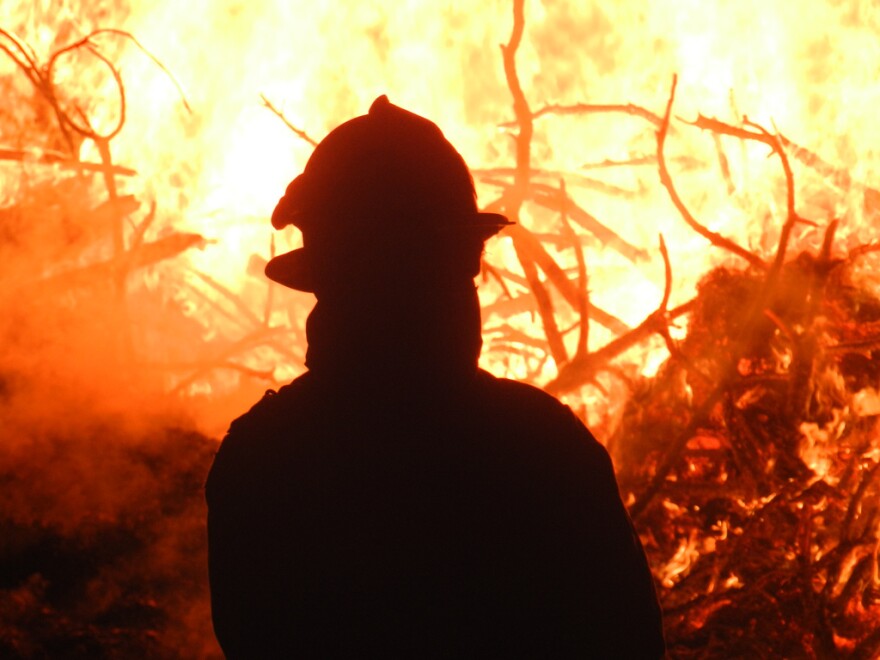Every year in the U.S., dozens of firefighters are killed in the line of duty. But there are hundreds more close calls, where a firefighter needs to be rescued after becoming injured or otherwise incapacitated. Virtually all firefighters, both volunteer and professional, rely on a simple device designed to alert their fellow firefighters when they need help.
It’s called a Personal Alert Safety System – or PASS. It’s basically a little sensor that measures whether the person wearing it is moving.
“After about five seconds of a firefighter not moving, it sends out a warning signal,” explains Joelle Suits, a graduate student at the University of Texas at Austin who’s studying fireground acoustics. “If the device doesn’t get any movement or any input from the firefighter, it goes into full-on alarm system.”
The device emits a series of loud chirpsdesigned to get the attention of other firefighters in the area. For the most part, it works really well. Suits says lots of firefighters owe their lives to the PASS, but there are times when it doesn’t work as well as it should.
“There were cases where firefighters would hear the device outside the house,” Suits said. “But once they got inside, they couldn’t hear it or couldn’t find it and they’re not entirely sure why.”
So Suits and some other researchers at UT-Austin are trying to figure out why – and maybe, build a better PASS alarm.
The first they’re doing is analyzing the sensory environment inside a burning building. And it might not be what you think.
“So when there’s a room on fire, people typically think ‘Oh, you know, you see the bright fire and you can still see other things’ – well, that’s Hollywood,” explains D.K. Ezekoye, a mechanical engineering professor at UT and one of the researchers on the PASS project.
In a real fire, he says, a firefighter probably can’t see a thing.
“They are in pitch black conditions and they have to rely on these other senses – particularly auditory in this case – to try to determine what’s going on.”
But hearing what’s going on isn’t so easy.
There’s sirens, water pumps, radio traffic, fans pushing smoke out of the building, saws – sometimes car alarms and smoke detectors. Plus, firefighters are wearing a helmet and protection around their face and ears – muffling the sounds around them.
And then things get weird.
The air is hotter or cooler in different places around a room that’s on fire.
“And sound moves faster in hotter temperatures than it does in cooler temperatures,” says Joelle Suits. “Which can distort and actually bend sound.”
Which can make it sound like a sound is coming from somewhere completely different than the actual source.
Which is a problem when you’re using that sound to locate a colleague in peril.
So what Suits, Ezekoye and their team are doing is trying to quantify all the other sounds in a fire and figure out how you could design an alarm signal that can compete.
“There’s most likely not going to be a specific signal that we come up with where we say ‘OK, this signal right here is the best signal,” Suits says. But there will be some guidelines. Right now, the national standard for a PASS requires it be 95db. They could find that simply making it louder would help. Or adjusting the frequency or pitch of the alarm.
But with all of its problems, is sound really the best way to find a firefighter who’s in trouble? What about GPS or some kind of homing beacon?
“All these other technologies, none of them has worked as well and as reliably as this simple sound beacon at this point,” said Ezekoye. “So we’re not trying to create a revolution, but it’s an evolution in terms of this particular technology.”
Maybe in the future, Ezekoye says, there will be some kind of hearing aid or something specially tuned to pick up and locate a signal from the PASS device.
But change in the fire service is slow to happen.
Standards for PASS devices were updated in 2007 when their resistance to heat and water were improved. But up until just this year, there was actually no universal standard for what the PASS alarm should sound like. Different manufacturers had different alarms.
The idea with the new standard is that no matter where you are, if you hear this one alarm sound, you’ll know a firefighter is in trouble. But the new alarm is just supposed to be universally recognized, not to necessarily be a better PASS alarm.
The UT researchers hope to have their guidelines for what that alarm should sound like sometime next year.





